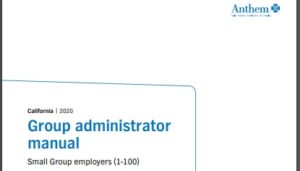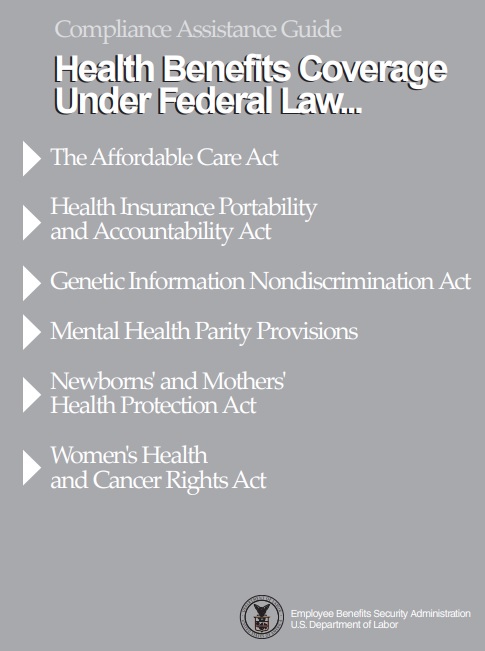Small Group Employer definition for Health Insurance
“Small employer” definition in California Insurance Code:
(A) … any person, firm, proprietary or nonprofit corporation, partnership, public agency, or association that is actively engaged in business or service, that, on at least 50 percent of its working days during the preceding calendar quarter or preceding calendar year, employed at least one, but no more than 100, eligible employees, HR 1624 Info the majority of whom were employed within this state, that was not formed primarily for purposes of buying health benefit plans, and in which a bona fide employer-employee relationship [Common law employee * Spouses don’t count] exists.
In determining the number of eligible employees, companies that are affiliated companies and that are eligible to file a combined tax return for purposes of state taxation shall be considered one employer. Insurance Code §10753
See rule and SB 1375 about the prohibition of Association Group Plans
More on definition
…
This subparagraph shall be implemented to the extent consistent with PPACA, except that the minimum requirement of one employee shall be implemented only to the extent required by PPACA.
(2) For plan years commencing on or after January 1, 2014, the definition of an employer, for purposes of determining whether an employer with one employee shall include sole proprietors, certain owners of “S” corporations, or other individuals, shall be consistent with Section 1304 of PPACA.
The term “small employer” means, in connection with a group health plan with respect to a calendar year and a plan year, an employer who employed an average of at least 1 but not more than 100 employees on business days during the preceding calendar year and who employs at least 1 employee on the first day of the plan year.] [42.usc.18024.b 2 def.employER (1304
The definition of Small Employer no longer includes self employed, Partners, Sole Proprietors & S Corps unless there is at least one common law employee. Since everything will be guaranteed issue for 1.1.2014 it’s OK as the one man shop or husband & wife group can get coverage as individuals regardless of health status. It should also be a tax write off. If the business isn’t making that much $$$ there are Tax Subsidies. Health Care Reform — Non Grandfathered Plans * AB 1083 * Insurance Code §10753
Self Employed?
- Self employed owners of a small business must have at least one non spousal, w-2 employee to qualify as a group.
- If you do have a non spousal employee on payroll, click here to get an Individual & Family quote. Under ACA/Obamacare your coverage is STILL guaranteed issue with no pre-existing condition clause.
- If your business isn’t as profitable as you’d like it to be, you can qualify for subsidies under Obamacare, it’s a function of MAGI – Modified Adjusted Gross Income, Line 11 on your 1040 tax return.
- The premiums for self employed are still deductible, line 29 of your 1040, learn more, whether you have an Individual Plan or a Group Health Premiums under Section §106 IRC. As long as the plan is for employees and if you have them, you’ll have to cover them to get the tax deduction.
- US News & World Report 11.28.2014 on advantages for self employed under Health Care Reform – Note though that in the past CA under AB 1672 – Self Employed could always get coverage!.
Tax Advantages
See our other pages on Employer – Employee Definition
Proofs you meet definition of Small Group Employer?
Just Enter your census or securely send us an excel spreadsheet or a list of employees and get instant proposals for California
Anthem Blue Cross
Group #Administrator Manual 9/2022 ONLINE
- Authoritative answers to questions like:
- Adding or Terminating Employees
- Our Video explanation - 2nd Video
- Late Enrollee's Page 32
- Cal COBRA Information
- Our Video explanation - 2nd Video
- Adding or Terminating Employees
- New Enrollment Checklist
Health Coverage #Guide
Art Gallagher
Health Care Reform FAQ's
Understanding Health Reform
***********************************
Compliance #Assistance Guide from DOL.Gov Health Benefits under Federal Law
- Health Care Reform Explained Kaiser Foundation Cartoon VIDEO
- Choosing a Health Plan for Your Small Business VIDEO DOL.gov
- ACA Quick Reference Guide California Small Group Employers Revision 2020 Word & Brown
- kff.org/health-policy-101/
IRS #Pub334
Tax Guide for Small Business
Schedule C
-
- IRS Small Business Self-Employed Tax Center VIDEO
- Our FAQ on Meals
-
IRS Small Business Self-Employed Tax Center VIDEO
- How to fill out a Schedule C Profit or Loss from Business VIDEO
- CA Tax Guide for Restaurant Owners
- Taxable and Nontaxable Income Publication 525
- Avalara Tax Compliance Guide for Business 2022 151 pages
- Affordable Care Act Tax Provisions for Employers
- 2024 Tax Reference Guide
Our webpages on
FAQ’s
- My wife and I own an S Corp. So, since we are employees, that makes us eligible to get a group plan, right?
- See links above for proofs needed to prove your a bonified business with # and the sample underwriting guide and administrative manual.
- How about a child who is an actual w-2 employee?
We want UCLA
Here are the Group Plans that we can get you that UCLA shows as accepted on their website
What is a #bona fide employer – employee relationship?
- Health Care Reform requires that one have a bona fide employer – employee relationship at common law, not husband & wife. Even if you had a group plan prior to ACA.
- See our page on 1099 Independent Contractors vs Employees & Owners
What is that? Why?
Legal Reasoning
I’ll grant, that I have trouble completely following the logic given to me by Covered CA, but I have to acknowledge that every Insurance Company agrees.
- only a small employer new definition of Small Employer §10753 (q) (1) may participate in the SHOP Small Employer Program Covered CA. 45 CFR 155.710:
- “Small employer” and “employer” are defined with reference to Section 2791 [300gg-91] of the Public Health Service Act.
- Employer has the meaning given to the term in section 2791 of the PHS Act, except that such term includes employers with one or more employees. All persons treated as a single employer under subsection (b), (c), (m), or (o) of section 414 of the Code are treated as one employer. CFR § 155.20.
- (a) (6) EMPLOYER .—The term ‘‘employer’’ has the meaning given such term under section 3(5) of the Employee Retirement Income Security Act of 1974, except that such term shall include only employers of two or more employees. Page 1533 Public Health Service Act
-
(d) other definitions
- Under Section 2791, “employer” is defined by reference to ERISA Section 3(5). [29 US Code §1002 Definitions]
- (5) The term ‘‘employer’’ means any person acting directly as an employer, or indirectly in the interest of an employer, in relation to an employee benefit plan; and includes a group or association of employers acting for an employer in such capacity.
- (6) The term ‘‘employee’’ means any individual employed by an employer. Page 9 ERISA.
- ERISA Section 3(5) requires that an employer employ at least one common law employee (i.e. someone other than the owner).
- IRS Common Law Employee
- Worker Classification 20 Factors
- Ascende Human Capital Consulting
-
- Under 29 C.F.R. 2510.3-3(c), a regulation adopted under ERISA, an employee does not include a sole proprietor or the sole proprietor’s spouse, or a partner in a partnership or the partner’s spouse. See also 77 Fed. Reg. 18399 (Mar. 27, 2012). (legal reasoning courtesy of Covered CA Facebook inquiry) SHOP Agent Guidelines
How many common law employees must be enrolled for coverage to be considered group coverage?
- A. For a group health plan to be considered a “group health plan” under the Employee Retirement Income Security Act (ERISA), there must be at least one common law employee enrolled.
- Pursuant to 29 C.F.R. 2510.2-3(b), an “employee benefit plan” does not exist if no “employees” are covered by the plan. Pursuant to 29 C.F.R. 2510.3-1 and 29 C.F.R. 2590.732(d) an “employee” does not include the sole owner of a business or a spouse of the business owner. New York.gov
See our other pages on Employer – Employee Definition
****
- Healthcare.gov
- If you’re self-employed with no employees, you’re not considered an employer. You can use Covered CA or Direct with Insurance Company to find coverage that fits your needs.
- sole proprietors and owners of S Corp – (Does not pay Federal Income Tax) can be small groups as long as the one employee is not the sole proprietor or their spouse blueshieldca.com
-
-
3. Additional attestation for establishing minimum group size:a. If my eligibility is required to meet the minimum group size to qualify for small group business coverage, I additionally attest that:I do not wholly own the above-named company with my spouse or on my own BC eligibility statement
-
- C Corp separate legal entity owned by shareholders
- S Corp – Does not pay Federal Income Tax
- Blue Shield Flyer Small businesses and the ACA Rev 3.2013 Michael Lujan was very explicit in 2 presentations to CAHU and LAAHU, an EE is someone who is listed on a DE 9C. Sole Proprietors and partners are normally not on a DE9C. The sole prop and partner can be included in a group plan IF they have at least one W2 EE listed on the DE9C.
Resources & Links
- §31.3401(c)-1 Employee.
- (b) Generally the relationship of employer and employee exists when the person for whom services are performed has the right to control and direct the individual who performs the services, not only as to the result to be accomplished by the work but also as to the details and means by which that result is accomplished.
- That is, an employee is subject to the will and control of the employer not only as to what shall be done but how it shall be done. In this connection, it is not necessary that the employer actually direct or control the manner in which the services are performed; it is sufficient if he has the right to do so.
- The right to discharge is also an important factor indicating that the person possessing that right is an employer.
- Other factors characteristic of an employer, but not necessarily present in every case, are the furnishing of tools and the furnishing of a place to work to the individual who performs the services.
- In general, if an individual is subject to the control or direction of another merely as to the result to be accomplished by the work and not as to the means and methods for accomplishing the result, he is not an employee.
- See our webpage on Employee vs 1099 Contractor
HR 1624
51 to 100 yes or no?
HISTORICAL
- §10753 (q) (1) “Small employer” Health Care Reform — Non Grandfathered Plans AB 1083 means either of the following:
- NOPE – See HR 1624 Below!!! However, CA could do it on their own
- For plan years commencing on or after January 1, 2016, any person, firm, proprietary or nonprofit corporation, partnership, public agency, or association that is actively engaged in business or service, that, on at least 50 percent of its working days during the preceding calendar quarter or preceding calendar year, employed at least one, but no more than 100, eligible employees,
- [Blue Cross FAQ’s 4.14.2015] There might be large premium increases as these groups go into the Small Group Market – where rating factors are limited and may lose large group purchasing power, discounts and group’s experience. Blue Shield Bulletin 7.9.2015 Click here for our Excel census form for your FREE Quote in CA or enter it ONLINE.
Blue Shield FAQ’s - [Some companies say one employee who could waive off if they have other group coverage and others say a common law employee MUST enroll. Email us [email protected] for a specific answer in your situation. See Participation Requirements]
- Legislation might be coming to change this CA Healthline 9.21.2015
HR 1624 just passed – President Obama just signed it CA Healthline 10.8.2015 Background CA Health Line 9.21.2015
SB 125 – CA adopts FT/FTE method to determine small group eligibility, same as ACA - Kaiser 10.8.2015 Agent Bulletin, CAHU and CA Healthline 10.20.2015 Health Net says definition already set in CA under AB 1083 and they are going ahead with the transition of 51 to 100 to Small Group.
Brother - Sister - Sibling Side Pages Subpages
View our website with your Desktop or Tablet for the most information
Technical Stuff
HISTORICAL
AB 1083 Bill Analysis 6.27.2011.senate 5.3.2011
Item # 5 in 8.30.2012 bill analysis ends choice for self employed to go into exchange as a group.
ORIGINAL…. 18) Permits a self-employed individual with specified income to, at his or her discretion, enroll in the Exchange as an individual rather than a small employer. [This is the 1st of 18 or so bill analysis posted on http://leginfo.legislature.ca.gov ]
Amendment to 10700 w —- (3) On or after January 1, 2014, a self-employed individual who obtains at least 50 percent of annual income from self-employment as demonstrated through personal income tax filings for the current or prior year. To the extent permitted under the federal Patient Protection and Affordable Care Act (Public Law 111-148) and any rules or guidance issued consistent with that law, a self-employed individual whose modified annual gross income is anticipated to be less than 400 percent of the federal poverty level may at his or her discretion seek to enroll as an individual rather than a small employer through the California Health Benefit Exchange.
Broker ONLY
HISTORICAL
A new law requires companies to include full-time and full-time-equivalent employees when determining group size
On January 1, 2016, California state law went into effect which redefined “small employer” to include groups of up to 100 employees. The determination of employer group size must be made annually and groups must adhere to the method for counting full-time employees and full time equivalent employees outlined in Section 4980H(c)(2) of the Internal Revenue Code. The definition of large group requires the group to have a combined total of at least 101 full-time and full-time-equivalent employees.
An example of how to determine whether a company is a small group for the purpose of purchasing group coverage is provided below. The methodology considers both full-time employees and full-time-equivalent employees.
- Company Y has 40 full-time employees for each calendar month during 2015.
- Company Y also has 20 part-time employees for each calendar month during 2015, each of whom has 60 hours of service per month.
- Now, combine the hours of service of the part-time employees for a month: [20 x 60 = 1,200].
- Dividing the combined hours of service of the part-time employees by 120* equals 10 [1,200/120 = 10]. This number, 10, represents the number of Company Y’s full-time equivalent employees for each month during 2015.
- Company Y adds up the total number of full-time employees for each calendar month of 2015, which is 480 [40 x 12 = 480].
- Company Y adds up the total number of full-time equivalent employees for each calendar month of 2015, which is 120 [10 x 12 = 120].
- Company Y adds those two numbers together and divides the total by 12, which equals 50 [(480 + 120 = 600)/12 = 50].
In this example company Y meets the size criteria for a small group because the total number of full-time and full-time equivalent employees for at least 50 percent of the preceding calendar year equals 50. Groups must consider additional IRS rules in making their final determination of whether the group is large or small, and some exceptions may apply.
On the Master Group Application for Small Business be sure to fill in Section 2, #8f. (In the scenario above, the number to fill in is 50 FTE and FTE Equivalent.) See the highlighted areas of section 2, page 2 of the application below.
We’re here to answer any questions you may have. Please call Producer Services at (if you have any questions.
* The number of 120 is stipulated by Internal Revenue Code 4980H(c)(2): “. . . in addition to the number of full-time employees for any month otherwise determined, include for such month a number of full-time employees determined by dividing the aggregate number of hours of service of employees who are not full-time employees for the month by 120”.
anchor 10753g









